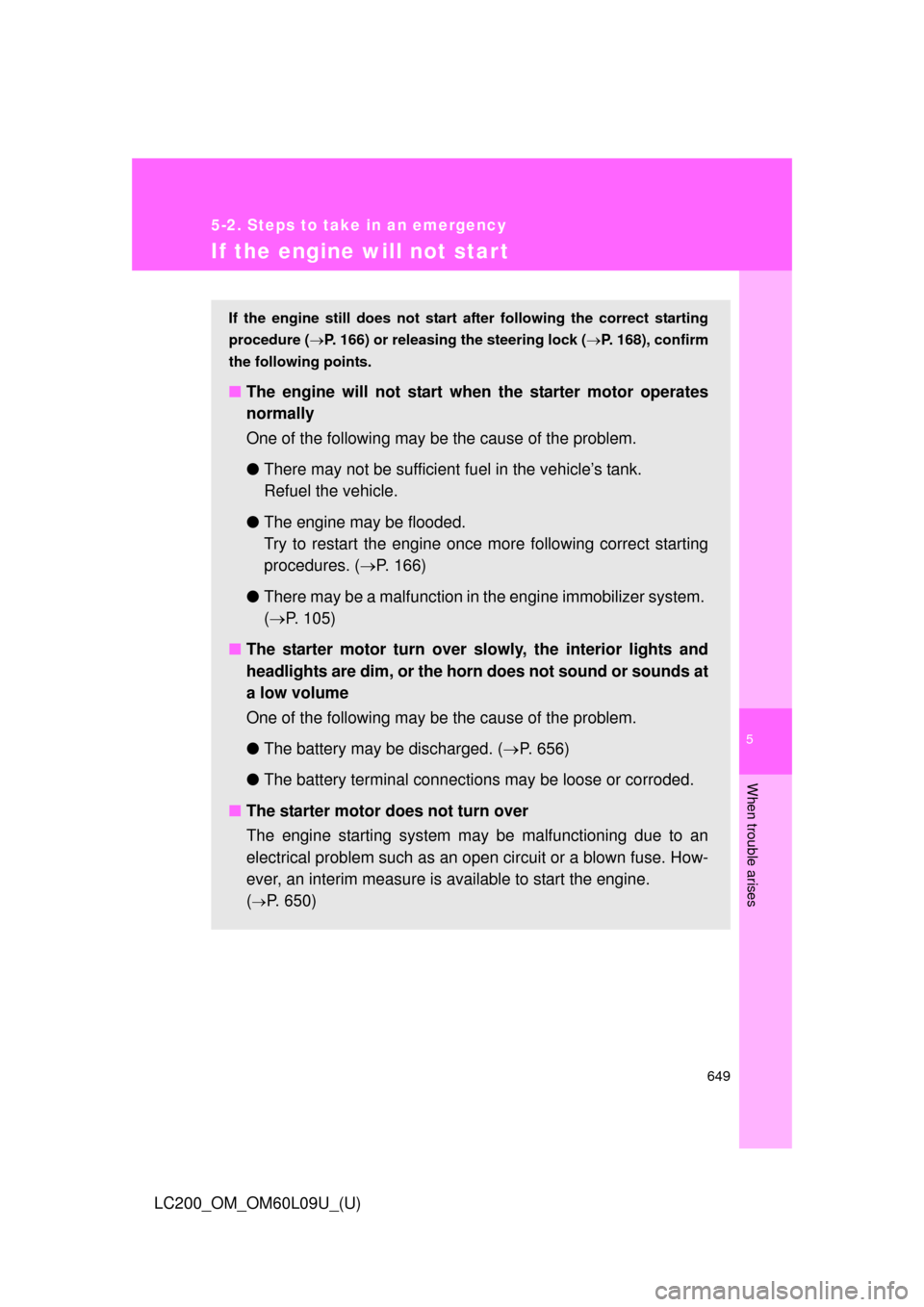Page 617 of 724

5
When trouble arises
617
5-2. Steps to take in an emergency
LC200_OM_OM60L09U_(U)
CAUTION
■Maintenance of the tires
Each tire, including the spare (if provided), should be checked monthly
when cold and inflated to the inflation pressure recommended by the
vehicle manufacturer on the vehicle
placard or tire inflation pressure
label (tire and load information label). (If your vehicle has tires of a differ-
ent size than the size indicated on the vehicle placard or tire inflation
pressure label [tire and load information label], you should determine the
proper tire inflation pr essure for those tires.)
As an added safety feature, your vehicle has been equipped with a tire
pressure monitoring system (TPMS-ti re pressure warning system) that
illuminates a low tire pressure telltal e (tire pressure warning light) when
one or more of your tires is significantly under-inflated. Accordingly,
when the low tire pressure telltale (tire pre ssure warning light) illumi-
nates, you should stop and check your tires as soon as possible, and
inflate them to the proper pressure. Driving on a significantly under-
inflated tire causes the tire to overheat and can lead to tire failure.
Under-inflation also reduces fuel effi ciency and tire tread life, and may
affect the vehicle’s handling and stopping ability.
Please note that the TPMS (tire pressure warning system) is not a sub-
stitute for proper tire ma intenance, and it is the driver’s responsibility to
maintain correct tire pressure, even if under-inflation has not reached the
level to trigger illu mination of the TPMS low ti re pressure telltale (tire
pressure warning light).
Page 618 of 724

618 5-2. Steps to take in an emergency
LC200_OM_OM60L09U_(U)
CAUTION
Your vehicle has also been equipped with a TPMS (tire pressure warning
system) malfunction indicator to indicate when the system is not operat-
ing properly. The TPMS (tire pressure warning system) malfunction indi-
cator is combined with the low tire pressure telltale (tire pressure
warning light). When the system det ects a malfunction, the telltale will
flash for approximately one minute an d then remain continuously illumi-
nated. This sequence will continue upon subsequent vehicle start-ups as
long as the malfunction exists. When the malfunction indi cator is illumi-
nated, the system may not be able to detect or signal low tire pressure
as intended.
TPMS (tire pressure warning system) malfunctions may occur for a vari-
ety of reasons, including the installati on of replacement or alternate tires
or wheels on the vehicle that prevent the TPMS (tire pressure warning
system) from functioning properly. Always check the TPMS (tire pres-
sure warning system) malfunction te lltale after replacing one or more
tires or wheels on your vehicle to ensure that the replacement or alter-
nate tires and wheels allow the TPMS (tire pressure warning system) to
continue to function properly.
NOTICE
■Precaution when installing a different tire
A tire of a different specification or maker may cause the tire pressure
warning system to not operate properly.
Page 619 of 724
5
When trouble arises
619
5-2. Steps to take in an emergency
LC200_OM_OM60L09U_(U)
If a warning message is displayed
The multi-information display shows warnings of system malfunc-
tions, incorrectly performed operations, or shows messages that
indicate a need for maintenance.
If a warning is shown on the multi- information display, stay calm and
perform the following actions:
Master warning light
The master warning light also
comes on or flashes in order to
indicate that a message is cur-
rently being displayed on the
multi-information display.
Multi-information display
If any of the warning messages is shown again after its correction
procedure has been performed, contact your Toyota dealer.
Page 623 of 724
5
When trouble arises
623
5-2. Steps to take in an emergency
LC200_OM_OM60L09U_(U)
(Flashes)
Indicates that the
moon roof is not fully
closed (with the
“ENGINE START
STOP” switch off, and
the driver’s door
open)
Close the moon roof.
(Flashes) Indicates, if the vehi-
cle reaches a speed of
3 mph (5 km/h), that
the parking brake is
still engaged.
Release the parking
brake.
Indicates that the
automatic transmis-
sion fluid temperature
is too high A buzzer also sounds. Stop the vehicle in a
safe place, shift the shift
lever to “P” and wait
until the light goes off.
If the light goes off,
you may start the vehi-
cle again. If the light
does not go off, con-
tact your Toyota
dealer.
Warning messageDetailsCorrection procedure
Page 628 of 724
628 5-2. Steps to take in an emergency
LC200_OM_OM60L09U_(U)
Have the malfunction repaired immediately.After taking the specified steps to correct the suspected problem,
check that the warning message and light go off.
Interior buzzerExterior buzzerWarning messageDetailsCorrection procedure
Once3 times
(Flashes) The electronic key
was carried out-
side the vehicle
and a door other
than the driver’s
door was opened
and closed while
the “ENGINE
START STOP”
switch was in a
mode other than
off.
Bring the
electronic
key back
into the
vehicle.
The driver’s door
was opened and
closed while the
electronic key was
not in the vehicle,
the shift lever was
in “P” and the
“ENGINE START
STOP” switch was
not turned off. Turn the
“ENGINE
START
STOP”
switch off
or bring the
electronic
key back
into the
vehicle.
Page 641 of 724
5
When trouble arises
641
5-2. Steps to take in an emergency
LC200_OM_OM60L09U_(U)
Pry off the wheel ornament,
using the beveled end of the
wheel ornament remover as
shown.
Slightly loosen the wheel nuts
(one turn).
STEP2
STEP3
Page 643 of 724
5
When trouble arises
643
5-2. Steps to take in an emergency
LC200_OM_OM60L09U_(U)
Position the jack at the jack
points as shown.
Front - Under the chassis frame
side rail
Rear - Under the rear axle hous-
ing
Raise the vehicle until the tire is
slightly raised off the ground.
Remove all the wheel nuts and
the tire.
When resting the tire on the
ground, place the tire so that the
wheel design faces up to avoid
scratching the wheel surface.
STEP5
STEP6
STEP7
Page 649 of 724

5
When trouble arises
649
5-2. Steps to take in an emergency
LC200_OM_OM60L09U_(U)
If the engine will not star t
If the engine still does not start after following the correct starting
procedure ( P. 166) or releasing the steering lock (P. 168), confirm
the following points.
■ The engine will not start when the starter motor operates
normally
One of the following may be the cause of the problem.
●There may not be sufficient fuel in the vehicle’s tank.
Refuel the vehicle.
● The engine may be flooded.
Try to restart the engine once more following correct starting
procedures. ( P. 166)
● There may be a malfunction in the engine immobilizer system.
( P. 105)
■ The starter motor turn over slowly, the interior lights and
headlights are dim, or the horn does not sound or sounds at
a low volume
One of the following may be the cause of the problem.
●The battery may be discharged. ( P. 656)
● The battery terminal connec tions may be loose or corroded.
■ The starter motor does not turn over
The engine starting system may be malfunctioning due to an
electrical problem such as an open circuit or a blown fuse. How-
ever, an interim measure is available to start the engine.
(
P. 650)